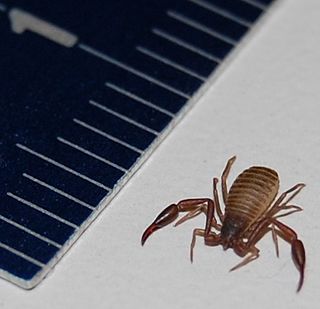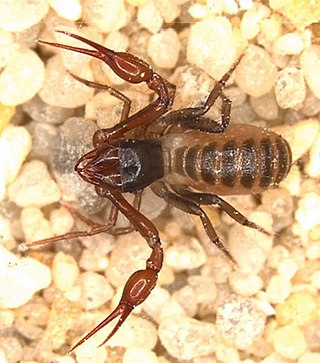
Pseudoscorpions, also known as false scorpions or book scorpions, are small, scorpion-like arachnids belonging to the order Pseudoscorpiones, also known as Pseudoscorpionida or Chelonethida.

The Pseudogarypidae are a small family of pseudoscorpions. Most recent species are found in North America, while one species is endemic to Tasmania.
Menthidae is a family of pseudoscorpions, first described by Joseph Conrad Chamberlin in 1930.

Chthoniidae is a family of pseudoscorpions within the superfamily Chthonioidea. The family contains more than 600 species in about 30 genera. Fossil species are known from Baltic, Dominican, and Burmese amber. Chthoniidae now includes the former families Tridenchthoniidae, and Lechytiidae which has been demoted to subfamilies.

Chernetidae is a family of pseudoscorpions, first described by Anton Menge in 1855.
Geogarypidae is a family of pseudoscorpions, which was described in 1930 by American arachnologist Joseph Conrad Chamberlin.

Garypinidae is a family of pseudoscorpions, first described by Eugen von Daday in 1889.
Atemnidae is a family of pseudoscorpions, first described by Kyukichi Kishida in 1929.
Garypidae is a family of pseudoscorpions, first described by Eugène Simon in 1879.

Garypus is a genus of pseudoscorpions in the family Garypidae. It was described by German arachnologist Ludwig Carl Christian Koch in 1873. The species are found mainly in tropical and subtropical areas, where they occupy supralittoral and littoral zones in seashore habitats.

Cheliferidae is a family of pseudoscorpions in the order Pseudoscorpiones, first described by Antoine Risso in 1827.
Ideoroncidae is a family of pseudoscorpions belonging to the order Pseudoscorpiones. Members of the family are known from Asia, Africa, western North America and South America.

Withiidae is a family of pseudoscorpions, first described by Joseph Conrad Chamberlin in 1931.
Lagynochthonius is a genus of pseudoscorpions in the family Chthoniidae. It was described in 1951 by Austrian arachnologist Max Beier.

Tyrannochthonius is a genus of pseudoscorpions in the family Chthoniidae. It was described in 1929 by American arachnologist Joseph Conrad Chamberlin.
Sathrochthonius is a genus of pseudoscorpions in the family Chthoniidae. It was described in 1962 by American arachnologist Joseph Conrad Chamberlin.

Pseudotyrannochthonius is a genus of pseudoscorpions in the family Pseudotyrannochthoniidae. It was described in 1930 by Austrian arachnologist Max Beier.
Hyidae is a family of pseudoscorpions. It was described in 1930 by American arachnologist Joseph Conrad Chamberlin.
Ideoblothrus is a genus of pseudoscorpions in the Syarinidae family. It was described in 1892 by Italian naturalist Luigi Balzan as a subgenus of Ideobisium.
Anagarypus is a genus of pseudoscorpions in the Garypidae family. It was described in 1930 by American arachnologist Joseph Conrad Chamberlin. Species in the genus are found on islands along the coast of northern Australia and in the Indian Ocean.









